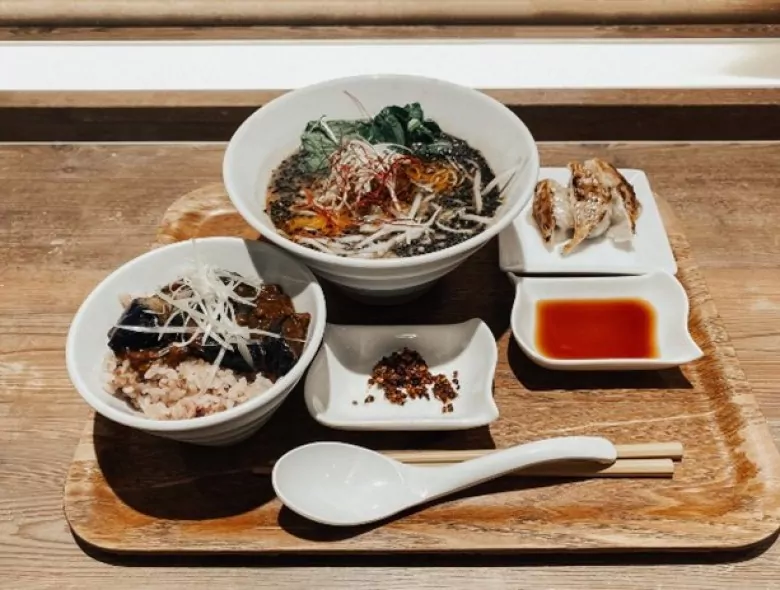
Fish is prevalent in the Japanese diet. Dashi (stock usually made from bonito shavings) can be hard to escape when you are looking for vegetarian meals or vegan food. It pops up in most soups in restaurants and inconspicuous sushi and onigiri at convenience stores.
However, like in so many other countries, vegetarianism and veganism lifestyles are becoming increasingly popular for a variety of reasons; to avoid supporting an industry that exploits animals, for maintaining a more sustainable lifestyle, health reasons, and other reasons too. This means that new restaurants are opening up almost every month, offering vegan food and vegetarian meals and making a more vegan Japan.

1. Shopping for vegetarian and vegan food
Fruit and vegetables can be costly, so if you’re looking to eat a lot of fruit and vegetables without spending too much consider buying frozen fruit and vegetables. Alternatively, check your local stores for their fresh produce. Shopping seasonally will also help to save money and as a bonus, it’s more sustainable too!
Gyomu Super is a chain of supermarkets in Japan that offers a lot of vegetarian-friendly products and international food at a lower price compared to most other supermarkets. Their affordable products mean you can make some delicious vegetarian meals.
Gyomu stores usually stock goods such as tinned tomatoes, tinned kidney beans, chickpeas, rice paper wraps, frozen wraps, pastry sheets, peanut butter, pittas, and frozen fruit and vegetables. They even stock jars of vegan pasta sauces including a vegan Bolognese. The goods they stock vary from time to time so make sure to check for any new products too!
Aeon supermarkets, especially the bigger stores, stock some great ingredients you might need for your vegetarian recipes. Their Topvalu vegetive range provides some specialist vegan food for a fairly reasonable cost.
A popular vegan shredded cheese alternative is the Topvalu Vegetive cheese available at most Aeon supermarkets. Aeon does have other vegetive vegan food but it’s important to check the ingredients list.
Some seemingly vegan food might contain animal products since soy meat is often seen as a substitute for meat to be healthier so it’s popular beyond the vegetarian community. Please always check the ingredients!
Specialist health food stores and international food stores are common in the bigger cities. If you’re looking to buy international products these stores provide a lot of unique goods from around the World, including specialist ingredients for vegan or vegetarian recipes. These shops are expensive though since the goods are usually imported.

2. Online Shops
There’s also a variety of online shops that provide vegetarian meals and vegan food. Amazon is a good place for buying big batches of oats, pulses, and specialist items like nutritional yeast.
Terra foods deliver products that make great vegan and vegetarian meals, check out their vegan minced meat and nuggets.
Osaka’s popular Canadian restaurant Slices has an online shop shipping homemade meat and cheese substitutes across Japan. The vegan feta is a highlight!
For your karaage fix, check out Karaage 2.0.

3. Happy Cow and the vegan and vegetarian in Japan community
A quick search online will reveal that there are so many vegan and vegetarian people in Japan – you are not alone!
If you have not yet heard of Happy Cow, it will change your life, revealing a whole vegan Japan, with all the vegan-friendly and vegetarian restaurants across the country. It’s a website and app where vegans and vegetarians can review and list restaurants and shops providing vegan food. It’s a great app to use to find independent restaurants whenever you are traveling to new places.
The Is It Vegan? Japan website is a great resource for finding vegan products available in Japan and checking what things potentially aren’t vegan food.
Another great place to look for updates on new vegetarian and vegan food and restaurants is social media. Vegan Japan is a really useful Facebook group, as well as the Tokyo Vegan and Vegetarian Hub.

4. Vegetarian ramen
If you are looking for vegetarian ramen at the convenience store keep your eyes peeled for Nongshim ramen (pictured above). This accidentally vegetarian ramen is a low-cost quick and easy meal and it’s vegan friendly. The made-in-Korea version is not vegetarian, but the ramen made in Japan is usually the one available at convenience stores (please make sure to double-check though).

5. Cooking vegetarian meals
If you cook most of your meals, two kitchen appliances might be worth investing in so that you can enjoy a larger variety of vegetarian meals.
An air fryer is great for making vegan karaage, healthier chips, even baking vegan bread if you’re feeling adventurous. If you’re considering whether an air fryer is a worthwhile investment as a vegan or vegetarian in Japan, check out our article on the benefits of air fryers.
Having a blender means you can prepare nutritious vegetable soups, hummus, cashew cheese, and smoothies with frozen fruit.
If you want to cook more Japanese-style vegetarian food try out this vegan okonomiyaki recipe. Embracing tofu is a great way to adapt to living as a vegetarian in Japan. It’s cheap and nutritious. If you don’t enjoy soft tofu try freezing, thawing, and pressing it twice, it’s a bit laborious but creates a meat-like texture ready to be seasoned and cooked for a delicious vegetarian meal.
Living in the inaka will inevitably be more of a challenge for living as a vegetarian, compared to the cities filled with international food and restaurants. I have actually found it easier to transition from vegetarian to vegan though since there are soy alternatives to dairy products. It is possible to keep up your vegetarian meals and lifestyle, and even have some fun getting creative with new vegetarian recipes!



